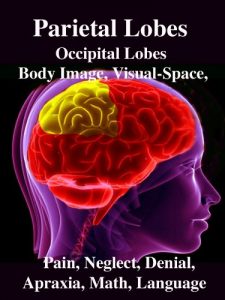Table of Contents
Part 1. Parietal Lobes:
Body Image, Visual Space, Neglect, Denial, the "Lobe of the Hand" Apraxia, Math, Language 4
Skin Receptors & Sensory Processing - 8
Parietal Topography & Functional Localization - 11
Primary Somesthetic Receiving Areas - 12
Body Image Representation - 16
Primary, Secondary andAssociation Sensory-Motor Areas - 17
Body Consciousness: Denial of the Body, and Phantom Limbs - 21
Functional Laterality - 24
Somesthetic Agnosias: Loss of Sensation - 26
Somesthetic Association Area - 28
Hand Manipulation Cells - 29
Body in Space - 31
Tactile Discrimination Deficits & Stereognosis - 32
Pain: Areas 5, 7, & the Supramarginal Gyrus - 34
Pain and Hysteria - 37
Area 7 & the Superior-Posterior Parietal Lobule - 38
Polymodal Information Processing - 38
Three-Dimensional Analysis of Body-Spatial Interaction - 38
Visual-Spatial Properties - 39
Visual Attention - 43
Motivational & Grasping Functions - 44
Fight & Left Parietal Lobe: Lesions & Laterality - 44
Neglect & Visual Space - 44
Localization of Objects in Space - 47
Apraxia - 47
Emotion - 48
Inferior Parietal Lobule & Language - 48
Multi-Modal Assimilation Area - 50
Language: IPL Interactions With Broca’s & Wernicke’s Areas - 51
Language & Anomia - 53
Word Finding: Knowing Yet Not Knowing: Disconnected Consciousness - 53
Agraphia - 56
Lateralized Temporal-Sequential functions - 56
Apraxiav57
Sensory Guidance of Movement - 57
Apraxia - 58
Ideomotor Apraxia - 60
Ideational Apraxia - 60
Left Sided or Unilateral Apraxia - 61
Dressing Apraxia - 61
Aphasia & Apraxia - 62
Pantomime Recognition - 62
Constructional Apraxia - 63
Gerstmann'sSyndrome - 66
Finger Agnosia, Acalculi, Agraphia, Left-Right Confusion: the Knowing Hand - 6
Finger Agnosia - 68
Evolution of Geometry & Math - 69
Acalculia - 75
Pure Acalculia/Anarithmetria - 76
Alexia/agnosia for Numbers - 76
Alexia/Agraphia for Numbers - 76
Spatial Acalculia - 77
Right-Left Disorientation - 77
Attention & Neglect - 78
Left Hemisphere Neglect - 82
Delusional Denial - 83
Disconnection, ConfaBulation & Gap Filling - 83
Delusional Playmates & Egocentric Speech - 85
Summary & Overview - 86
Part II: Occipital Lobes Vision, Blind Sight, Hallucinations, Visual Agnosias - 88
Primary & Association Visual Cortex - 92
Pre-Cortical Visual Analysis - 96
Neocortical Columnar Organization - 102
Simple, Complex, Lower & Higher Order Hypercomplex Feature Detectors - 103
Striate Cortex: Area 17 - 105
Hallucinations - 107
Visual Association Areas 18 & 19 - 107
Temporal Parietal Visual Areas - 108
Multiple Visual Realities - 110
Homonymous Hemianopsia & Quadrantanopsia - 111
Hallucinations - 112
Cortical Blindness - 113
"Blind Sight" - 114
Denial of Blindness - 118
Visual Agnosia & Alexia - 118
Prosopagnosia - 121
Simultanagnosia - 122
Impaired Color Recognition- 123
Overview - 123
Part 1. Parietal Lobes:
Body Image, Visual Space, Neglect, Denial, the "Lobe of the Hand" Apraxia, Math, Language 4
Skin Receptors & Sensory Processing - 8
Parietal Topography & Functional Localization - 11
Primary Somesthetic Receiving Areas - 12
Body Image Representation - 16
Primary, Secondary andAssociation Sensory-Motor Areas - 17
Body Consciousness: Denial of the Body, and Phantom Limbs - 21
Functional Laterality - 24
Somesthetic Agnosias: Loss of Sensation - 26
Somesthetic Association Area - 28
Hand Manipulation Cells - 29
Body in Space - 31
Tactile Discrimination Deficits & Stereognosis - 32
Pain: Areas 5, 7, & the Supramarginal Gyrus - 34
Pain and Hysteria - 37
Area 7 & the Superior-Posterior Parietal Lobule - 38
Polymodal Information Processing - 38
Three-Dimensional Analysis of Body-Spatial Interaction - 38
Visual-Spatial Properties - 39
Visual Attention - 43
Motivational & Grasping Functions - 44
Fight & Left Parietal Lobe: Lesions & Laterality - 44
Neglect & Visual Space - 44
Localization of Objects in Space - 47
Apraxia - 47
Emotion - 48
Inferior Parietal Lobule & Language - 48
Multi-Modal Assimilation Area - 50
Language: IPL Interactions With Broca’s & Wernicke’s Areas - 51
Language & Anomia - 53
Word Finding: Knowing Yet Not Knowing: Disconnected Consciousness - 53
Agraphia - 56
Lateralized Temporal-Sequential functions - 56
Apraxiav57
Sensory Guidance of Movement - 57
Apraxia - 58
Ideomotor Apraxia - 60
Ideational Apraxia - 60
Left Sided or Unilateral Apraxia - 61
Dressing Apraxia - 61
Aphasia & Apraxia - 62
Pantomime Recognition - 62
Constructional Apraxia - 63
Gerstmann'sSyndrome - 66
Finger Agnosia, Acalculi, Agraphia, Left-Right Confusion: the Knowing Hand - 6
Finger Agnosia - 68
Evolution of Geometry & Math - 69
Acalculia - 75
Pure Acalculia/Anarithmetria - 76
Alexia/agnosia for Numbers - 76
Alexia/Agraphia for Numbers - 76
Spatial Acalculia - 77
Right-Left Disorientation - 77
Attention & Neglect - 78
Left Hemisphere Neglect - 82
Delusional Denial - 83
Disconnection, ConfaBulation & Gap Filling - 83
Delusional Playmates & Egocentric Speech - 85
Summary & Overview - 86
Part II: Occipital Lobes Vision, Blind Sight, Hallucinations, Visual Agnosias - 88
Primary & Association Visual Cortex - 92
Pre-Cortical Visual Analysis - 96
Neocortical Columnar Organization - 102
Simple, Complex, Lower & Higher Order Hypercomplex Feature Detectors - 103
Striate Cortex: Area 17 - 105
Hallucinations - 107
Visual Association Areas 18 & 19 - 107
Temporal Parietal Visual Areas - 108
Multiple Visual Realities - 110
Homonymous Hemianopsia & Quadrantanopsia - 111
Hallucinations - 112
Cortical Blindness - 113
"Blind Sight" - 114
Denial of Blindness - 118
Visual Agnosia & Alexia - 118
Prosopagnosia - 121
Simultanagnosia - 122
Impaired Color Recognition- 123
Overview - 123












